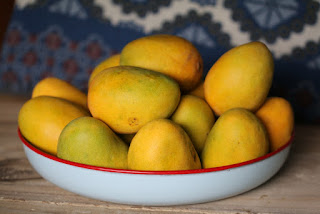Common name: mango
Botanical name: Mangifera indica
Yoruba name:
Mangoro
Igbo name:
Mangolo
Hausa name:
Mangwaro
Mango fruit is a drupe, or stone fruit, which means
that it has a large seed in the middle. Mango fruit is one of the most popular, nutritionally rich
fruits with unique flavor, fragrance, taste, and heath promoting qualities,
making it the best among new functional foods. The outer skin (pericarp) of
mangoes is smooth and is green in un-ripe mangoes but turns in ripe fruits into
golden yellow, crimson red, yellow or orange-red depending upon the cultivar
type. Fresh mango season lasts from April until August.
Mango
comes in different shapes and sizes depending upon cultivar types. Internally,
its flesh (mesocarp) is juicy, orange-yellow in color with numerous soft
fibrils radiating from its centrally placed flat, oval-shaped stone (enveloping
a single large kidney-shaped seed). It has a pleasant and rich flavor with a
sweet taste. A high-quality mango fruit should feature no or very less fiber
content and minimal tartness. Mango seed (stone) may either has a single
embryo, or sometimes polyembryonic.
HOW
TO SELECT AND STORE YOUR MANGO
Choose
mangoes with intact skin without any bruises or cuts, thus unripe mangoes can
be kept at room temperature for few days, and to ripen, keep them in paper
covers while ripe fruits should be stored in the refrigerator but never below
10° F (50°C). Bring back to normal temperature when the fruit is to be eaten to
get the natural taste and flavor.
watch out for our next post on mango.
To make enquiries about agrikweens
Contact
Phone: 08149355316
Follow us
Facebook: agrikweens; ARMI
Email: agrikweens@gmail.com; info@armi.com.ng
Twitter: https://twitter.com/agrikweens?s=08
Linkedin : agrikweens
Instagram: https://www.instagram.com/agrik_kweens?r=nametagwebsite: www.armi.com.ng


Comments
Post a Comment